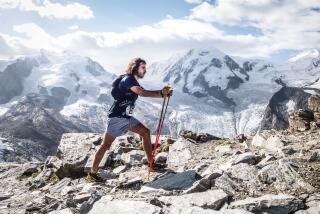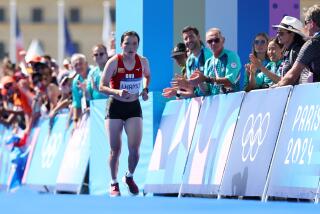Steady Diet of Marathons Works for This Vegetarian
When he left his Ohio hometown five years ago and took off for the Oregon countryside, his hair cascaded halfway down his back. “Almost down to here,” Ric Sayre remembered, cupping his palm at the base of his spine. “You think it’s long now, you should have seen it then.”
He was a child of the Sixties, stranded in the Eighties, without a “Back to the Future”-style vehicle to transport him through time. But at least his father, an Akron cop, never peppered him with scoldings about getting a haircut. He let the boy go his own road.
This eventually directed him to the wilderness fringes of Ashland, Ore., population 15,000 or so, where no one feels compelled to look or behave a certain way. There, he and a girlfriend share a house on a six-acre plot with another couple. Sometimes they run together in the mountains. Other times they pile into his ’77 Datsun pickup with the irritable transmission and truck into town.
He has no steady job. Thirty-two years old and still in college. A veteran vegetarian. A guy who is thinking about guitar lessons. A guy heavily into healthy food and good music and the great outdoors. An absolute Bill Walton throwback. “I guess you could say one of the things that appealed to me about Ashland was that it accepted a hippie-community life style,” he said. “I’ve always been sort of counter-culture.”
Now that Ric Sayre, the hippy-dippy distance runner, has won the San Francisco, Long Beach and Los Angeles marathons in the space of a single year--two of them in the last five weeks--he might single-handedly revive the movement. Start wearing tie-dyed T-shirts with peace symbols and handwritten slogans about LSD and LBJ. Nah. Ric Sayre is simply a very nice young man who has discovered a very nice way to avoid three-piece suits and 9-to-5 clocks. Whatever salary he makes, he earns by winning 26.2-mile runs. And by winning Sunday’s L.A. Marathon, he collected $10,000 cash, $5,000 worth of round-trip airplane tickets and a 1986 Mercedes 190E worth 25 grand.
“I’ve never even sat in a Mercedes,” he said.
The collecting is often more difficult than the winning. Sayre usually sells the prizes he wins, since they account for all of his income. But the new Audi he acquired by finishing first in the San Francisco marathon did not arrive for several months, and the same thing happened with the large cash prizes he had coming after taking a couple of races in Canada. He hopes the Mercedes arrives quickly; the newer the car, the larger the resale.
At the rate he is going, Ric Sayre is either going to have a pretty decent savings account or a driveway full of foreign cars. The man is a marathon machine. Some runners take weeks, even months, to recuperate from one race and start preparing for another. Not Sayre. He plans to run seven or eight this year, including Stamford, Conn., on Apr. 13 and Pittsburgh May 18. He enters marathons the way lottery players enter corner markets.
“The more I run, the better I run. I tend to recover real well from marathons,” he said after Sunday’s race, at which point he looked so refreshed, he could have run all the way to Long Beach, where he won a marathon Feb. 2.
“When I ran a personal best in Boston in 1983, it was my third marathon in 60 days,” Sayre said.
About the only thing visibly wrong with the winner after chugging for a fraction short of 2 hours and 13 minutes--a new personal best, by the way--was the small, bloody puddle atop the toes of his right shoe. Unorthodox from head to heel, Sayre wears a thin-soled track shoe when he runs, and his right foot, being slightly larger than the left, takes a pounding. “I don’t know if you noticed the shoes he wore,” Rod Dixon of New Zealand, who placed third, said later, “but they were not designed for road-racing. They’re more for indoor track or cross-country running.”
“I read in Scientific American that too much cushioning isn’t good for you,” Sayre explained. This is not a guy who subscribes only to Runner’s World magazine.
Sayre took the lead Sunday about 11 miles into the race and never lost it, holding off a late challenge from runner-up Gidamis Shahanga of Tanzania. Sayre and Shahanga also finished 1-2 in the 1985 San Francisco Marathon, but Sayre used a different tactic, kicking past Shahanga late in the race.
The winning time of 2:12.59 easily outclassed most of the 11,000-odd entries, but it was far from fleet. Sixty-six men already have done 2:10 or better. Carlos Lopes, who won the 1984 Olympic marathon, produced the best marathon clocking ever, 2:07.12, last April at Rotterdam. “Running the times he did, in his late 30s, gives me a lot of hope,” Sayre said.
The 135-pound Sayre was attending Akron Hoban High School, at about the same weight, when he realized that he was never going to be physically ready for what he calls “the glory sports,” football and basketball and such. “I noticed I was quicker than some of the other neighborhood kids, but when I went out for the team at school I was one of the slowest guys, so they made me run the half-mile.”
When Hoban’s cross-country team placed fifth in the state, Sayre was only the third-fastest man. Paul Bickel and John Brickles were quicker. Brickles, now living in San Antonio, Tex., could hardly believe it when he turned on ESPN one night and saw his old teammate winning West Coast marathons. “He wrote me a letter,” Sayre said. “I guess he was as surprised as I was that I turned out to be pretty good.”
Sayre stayed in Akron and worked in a store that specialized in goods for runners. When one of the owners, a friend, died, Sayre and a woman friend decided maybe it was time for a change. They had heard about Ashland, with its rustic setting and its annual nine-month Shakespeare festival. “A lot of creative people thrive in a setting like that,” Sayre said.
He takes classes at nearby Southern Oregon State and thinks about teaching elementary school someday. He has no interest in moving closer to Eugene, Ore., where many of America’s top runners go to train, preferring to run alone or with his friends through the hills.
“I enjoy my own space,” he said. “Maybe it’s my ego, but I’d rather be isolated and do things by myself than be part of some organized ritual. I mean, I just can’t see how that would be all that cool.”
More to Read
Sign up for The Wild
We’ll help you find the best places to hike, bike and run, as well as the perfect silent spots for meditation and yoga.
You may occasionally receive promotional content from the Los Angeles Times.






